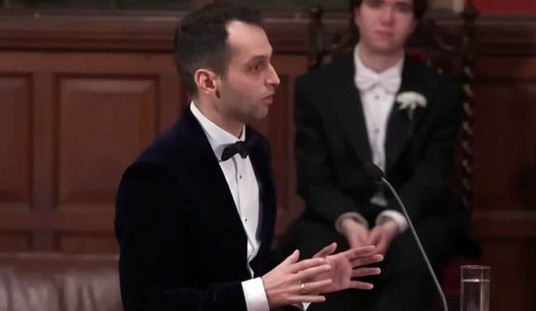Never mind that three states run by Democratic governors haven’t figured out how to deliver on promises for single-payer health care. At least a dozen Democrats running in gubernatorial races have quadrupled down on socialized medicine, either through Medicare for All or pledging to create state-based single payer systems, Dave Weigel reports for the Washington Post. What they can’t explain is how to pay for it — or even if they care about doing so:
Wherever he takes his campaign for governor, Abdul El-Sayed is followed by activists handing out information about “Medicare for all.” When he grabs the microphone, El-Sayed makes a promise: He’ll bring universal health care to Michigan.
“Why can the CEOs of big insurance corporations take home $13 million a year when 600,000 Michiganders still don’t have access to health care?” asked El-Sayed, who is a doctor, at a campaign stop last week in one of the state’s poorest cities. “When are we going to have leadership that stands up for statewide Medicare for all?”
El-Sayed, who campaigned this weekend with Sen. Bernie Sanders (I-Vt.) before Tuesday’s primary, is one of at least a dozen Democrats running for governor this year on a pledge to do what no state has ever done: give basic health insurance to everyone, no matter the cost.
The single-payer Democrats are on the ballot in red and blue states and from California, where Lt. Gov. Gavin Newsom is the heavy favorite to win in November, to Massachusetts, where Democrat Jay Gonzalez believes the issue will give him an opening against a popular Republican governor.
The California pledge is especially notable. The Democrat-dominated assembly ended up tabling a proposal to create a single-payer health care system in the state after getting cost estimates of $400 billion a year for the state senate’s bill. That’s more than twice the state’s annual budget as it is, and the state senate made no matter of the costs either, failing to even propose a funding mechanism for it. Gavin Newsom is the current lieutenant governor of the state; why not act now for single payer? Does Newsom have some funding plan to cover the costs? Apparently not.
This follows the faceplants in Vermont and in Colorado. Governor Peter Shumlin pledged to install a single-payer system when elected several years ago, but soon discovered that costs actually do matter. When it became apparent that Vermont would have to impose an income tax of 9.5% on individuals and higher rates on businesses just to come close to funding the system, Shumlin quietly dropped the idea. In Colorado, taxpayers scotched the proposal when it became clear that the system would not only cost a ton of money, but that it would result in rationing of care.
Many of them will end up arguing in support of Medicare for All, which has the attractive virtue of being out of the hands of the governors entirely. Why not run on a policy that doesn’t require any responsibility? However, as Charles Blahous explains at length in an E21 follow-up to his Mercatus study, the costs would far exceed any previous attempts at revenue collection — and that one key assumption is almost certain to blow up if M4A is ever implemented:
How best to understand the real-world magnitude of such an eye-popping number [$32.6 trillion over ten years]? The annual marginal cost of enacting M4A starts out at around 10.7% of GDP and rises to 12.7% of GDP within the first 10 years, continuing to grow beyond that. As the study explains, even a doubling of all projected individual and corporate income taxes would be insufficient to finance these added federal costs.
We have never undertaken a sudden, permanent expansion of government of this size. Total federal spending under M4A on healthcare alone would equal 17.9% of GDP in 2022 and rise to 20.8% of GDP by 2031. For context, consider that all US government spending this year totals 20.6% of GDP. And it bears repeating: even these numbers understate the likely cost of M4A.
The M4A runs into the same utilization buzz saw seen in the state proposals. Namely, generating higher demand while cutting provider payments by 40% will create a national nightmare as providers exit markets and people wait to access those that remain:
The text of the M4A bill specifies that healthcare providers will be paid at Medicare payment rates, which are roughly 40% lower than the rates paid by private insurance. Previous studies published by the Urban Institute as well as Emory professor Kenneth Thorpe (prior to the bill’s introduction) assumed this would not be possible, because such dramatically reduced payment rates would be well below providers’ reported costs of delivering services. My study took first a literal interpretation of the bill’s text: that these dramatic provider cuts would be implemented immediately.
It need hardly be said that cutting provider payment rates by roughly 40% for those now working through private insurance — down to below their reported costs of providing services — while at the same time increasing service demand by 11%, would have potentially dire and unforeseeable effects on the availability, timeliness, and quality of healthcare. Understand, these are not gradual cuts in the manner of the Affordable Care Act, but rather immediate cuts upon implementation of M4A. We simply do not know what would happen if the literal text of the M4A bill were carried out. But obviously, if we assume provider payments are suddenly cut by 40%, national health expenditures would naturally fall relative to current projections.
In recognition of the unlikelihood of such dramatic provider cuts being implemented as written, the study contains an alternate scenario in which payments to providers remain unchanged as a national average. Under that scenario, national health expenditures under M4A would rise even faster than under current law, and the price tag for federal taxpayers would rise to $38 trillion.
In other words, slogans don’t make for good policies. We can’t tax enough to pay for these systems, either on a state or federal level, and the only alternative will be sharp rationing of care, just as we see in our current single-payer systems, the VA and Indian Health Services. “No matter the costs” means “we don’t know how to deal with the costs.”
That, at least, hasn’t changed much. Here’s a fun flashback to last year, when Jake Tapper challenged Bernie Sanders to explain how he planned to push Medicare for All when even his own state had to renege on its single-payer pledge.









Join the conversation as a VIP Member